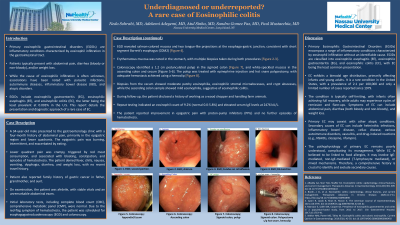Monday Poster Session
Category: Colon
P2076 - Underdiagnosed or Underreported? A Rare Case of Eosinophilic Colitis, Case Report
Monday, October 28, 2024
10:30 AM - 4:00 PM ET
Location: Exhibit Hall E

Has Audio

Neda Sohrabi, MD
Nassau University Medical Center
East Meadow, NY
Presenting Author(s)
Neda Sohrabi, MD, Adekemi Adeyemi, MD, Atul Sinha, MD, Sandra Gomez, MD, Paul Mustacchia, MD, MBA
Nassau University Medical Center, East Meadow, NY
Introduction: Primary eosinophilic gastrointestinal disorders (EGIDs) are a group of inflammatory disorders that involve eosinophil infiltration of the GI tract without a clear cause. EGIDs include eosinophilic gastroenteritis (EG), eosinophilic esophagitis (EE), and eosinophilic colitis (EC), with EC being the least common. This report highlights the presentation and diagnostic approach of a rare case of EC.
Case Description/Methods: A 34-year-old male presented with four months of intermittent epigastric and lower quadrant pain which worsens after eating especially red meat. He described the lower quadrant pain as crampy, associated with bloating, constipation, and hematochezia. He had no recent travels and reported a history of wood chopping, handling farm animals, and a family history of gastric cancer. Physical examination and initial lab tests, including CBC, CMP, LFTs were unremarkable, except for an eosinophil count of 9.2% and an elevated serum IgE level of 2476 kU/L. Stool ova and parasite was negative. Due to hematochezia, the patient underwent an EGD and colonoscopy. The colonoscopy revealed white-speckled mucosa in the ascending colon and cecum and a 1.2 cm pedunculated polyp in the sigmoid colon. Biopsies indicated eosinophilic colitis with moderate patchy eosinophilia, eosinophilic cryptitis, and crypt abscesses. Patient was started on PPI and during follow-up, reported symptom resolution.
Discussion: Primary EGIDs are inflammatory disorders involving eosinophil infiltration without a known cause. EGIDs can be classified as EE, EG, and EC with EC being the most uncommon presentation of EGIDs. EC has a bimodal age distribution, infants and young adults. It tends to be self-limiting in infants but can have periods of remission and flare-ups in adults. Primary EC is a rare condition with prevalence of 2.1/100,000 in America with only few cases reported since 1979. EC generally presents with abdominal pain, bloody or non-bloody diarrhea, and/or weight loss. It is believed that EC is related to food allergies, however that can be better classified as IgE-mediated, non-IgE-mediated (T-lymphocyte mediated) and/or a mix of both. Primary EC can be associated with other atopic conditions whereas secondary causes of EC can include helminthic infections, IBD, celiac disease, various autoimmune disease, vasculitis, drug-induced (ex. NSAIDs, Clozapine, Rifampin). Limited available data on the diagnostic approach for EC may contribute to underdiagnosing and underreporting of the disorder.

Disclosures:
Neda Sohrabi, MD, Adekemi Adeyemi, MD, Atul Sinha, MD, Sandra Gomez, MD, Paul Mustacchia, MD, MBA. P2076 - Underdiagnosed or Underreported? A Rare Case of Eosinophilic Colitis, Case Report, ACG 2024 Annual Scientific Meeting Abstracts. Philadelphia, PA: American College of Gastroenterology.
Nassau University Medical Center, East Meadow, NY
Introduction: Primary eosinophilic gastrointestinal disorders (EGIDs) are a group of inflammatory disorders that involve eosinophil infiltration of the GI tract without a clear cause. EGIDs include eosinophilic gastroenteritis (EG), eosinophilic esophagitis (EE), and eosinophilic colitis (EC), with EC being the least common. This report highlights the presentation and diagnostic approach of a rare case of EC.
Case Description/Methods: A 34-year-old male presented with four months of intermittent epigastric and lower quadrant pain which worsens after eating especially red meat. He described the lower quadrant pain as crampy, associated with bloating, constipation, and hematochezia. He had no recent travels and reported a history of wood chopping, handling farm animals, and a family history of gastric cancer. Physical examination and initial lab tests, including CBC, CMP, LFTs were unremarkable, except for an eosinophil count of 9.2% and an elevated serum IgE level of 2476 kU/L. Stool ova and parasite was negative. Due to hematochezia, the patient underwent an EGD and colonoscopy. The colonoscopy revealed white-speckled mucosa in the ascending colon and cecum and a 1.2 cm pedunculated polyp in the sigmoid colon. Biopsies indicated eosinophilic colitis with moderate patchy eosinophilia, eosinophilic cryptitis, and crypt abscesses. Patient was started on PPI and during follow-up, reported symptom resolution.
Discussion: Primary EGIDs are inflammatory disorders involving eosinophil infiltration without a known cause. EGIDs can be classified as EE, EG, and EC with EC being the most uncommon presentation of EGIDs. EC has a bimodal age distribution, infants and young adults. It tends to be self-limiting in infants but can have periods of remission and flare-ups in adults. Primary EC is a rare condition with prevalence of 2.1/100,000 in America with only few cases reported since 1979. EC generally presents with abdominal pain, bloody or non-bloody diarrhea, and/or weight loss. It is believed that EC is related to food allergies, however that can be better classified as IgE-mediated, non-IgE-mediated (T-lymphocyte mediated) and/or a mix of both. Primary EC can be associated with other atopic conditions whereas secondary causes of EC can include helminthic infections, IBD, celiac disease, various autoimmune disease, vasculitis, drug-induced (ex. NSAIDs, Clozapine, Rifampin). Limited available data on the diagnostic approach for EC may contribute to underdiagnosing and underreporting of the disorder.

Figure: Colonoscopy images
Disclosures:
Neda Sohrabi indicated no relevant financial relationships.
Adekemi Adeyemi indicated no relevant financial relationships.
Atul Sinha indicated no relevant financial relationships.
Sandra Gomez indicated no relevant financial relationships.
Paul Mustacchia indicated no relevant financial relationships.
Neda Sohrabi, MD, Adekemi Adeyemi, MD, Atul Sinha, MD, Sandra Gomez, MD, Paul Mustacchia, MD, MBA. P2076 - Underdiagnosed or Underreported? A Rare Case of Eosinophilic Colitis, Case Report, ACG 2024 Annual Scientific Meeting Abstracts. Philadelphia, PA: American College of Gastroenterology.
